Yeah, fair enough, good call, I can see how it unfolded.Well, when you pay extra to have a signature required from the person receiving the delivery, and the driver wrote my name , in cursive, for the signature to release the package, I would consider that forging my signature, but maybe I'm wrong??
Also, I have been a delivery driver for about 30 years, for small and large companies, including Staples for 8 years, so I know the pressure of getting 100 deliveries done in a short amount of time, across many miles.
I also didn't plan on getting him fired, but my complaint to his supervisor seemed to be the last of many complaints, and wasn't the first problem I had with this driver.
You might wonder why I had his super's cellphone number? Because he personally called me to straighten out other mishaps, and wanted me to call him directly if there were any further problems. This time ended up getting him relieved of his duties.
-
WANTED: Happy members who like to discuss audio and other topics related to our interest. Desire to learn and share knowledge of science required. There are many reviews of audio hardware and expert members to help answer your questions. Click here to have your audio equipment measured for free!
- Forums
- Audio, Audio, Audio!
- Headphones and Headphone Amplifier Reviews
- Headphone & IEM Reviews & Discussions
You are using an out of date browser. It may not display this or other websites correctly.
You should upgrade or use an alternative browser.
You should upgrade or use an alternative browser.
TRUTHEAR x Crinacle Zero IEM Review
- Thread starter amirm
- Start date
raif71
Major Contributor
- Joined
- Sep 7, 2019
- Messages
- 2,342
- Likes
- 2,542
I agree. To me these illustrations are not humans. Look at them big eyes, sometime no nose characters and other disproportionate body figures. Not humans lol. W in WAF may have a new meaning in the audio industy ...some of you guys are just WOKESeeing all those hate comments make me just. You guys just need to chill. There's only a nice artwork. So what? It's only artwork about fiction anyway.
- Joined
- Jun 16, 2021
- Messages
- 25
- Likes
- 33
Do they sell replacement ear tips? I don't see any on their website.
Luckily you can just toss the outer sleeve, and the inner packaging, sit back and enjoy the sound these make.
I am also wondering what the different diameters of the ear tips inner holes change sound wise, since I can't swap them fast enough to notice much of anything.
I am also wondering what the different diameters of the ear tips inner holes change sound wise, since I can't swap them fast enough to notice much of anything.
If I understand the Harman research correctly then the research produced a probability on preference with these factors as unknown variables, in other words the variability of anatomy is priced in to the model. Unless we have the ability to quantify these variables (which end users don’t) then target compliance becomes the only objectively valid variable on likely preference that we have. As you say it’s not the beginning and end of variables that we should care about, but it is the only known one available to us.
Exactly. It needs to be understood this is all implicitly a probabilistic exercise. When I say people are not listening to the Harman target when they buy the Truthear, in full this means 'you're likely not listening to as close to the Harman target, and therefore the frequency response you're statistically most likely to prefer, as you can'. But that's a mouthful so I'm not going to say that every time. The only variable the end user can control in all this is frequency response via EQ, and having a plethora of headphone measurements and people like Oratory and @Maiky76 producing EQs that take the frequency response very close to the Harman target, we can all achieve this. From that point of course you can then adjust the EQ filters to preference if you feel the need (which Oratory makes very easy to do with his choice of filters and explanations of their subjective effects in his pdfs). But starting at the Harman target will for the majority likely get them closest to their preference quickest (and that's why Oratory tries to match the target so closely, within reason of course, in order for it to be most likely the EQ is preferred by the majority of users).I suppose there is still the argument that if the dummy head measurement shows a deviation from the target curve which is covering a wide enough span of frequencies with enough difference in dB that it can be an audible difference, then you could argue that applying that EQ filter to bring it onto the Target Curve would result in an audible difference within your own unit that you're listening to. Of course though, you can make the points you made that you can't guarantee the exact frequency response you're receiving due to unit to unit variation & anatomy differences, and therefore that small change that is being made in the suggested EQ filter might be pushing it in the wrong or right direction - that's applicable to all EQ. But, on average, if the research is good that created the Harman Target and given the measurement you're using for your IEM is a good statistical average, then there is some merit of trying to get as close to the Target Curve as possible when using EQ (as there is no reason to "add ways in which the unit may vary from the Target Curve") - but of course only within the relevance of whether or not you could hear the difference between that filter being activated or deactivated......although I kind of believe in the idea of cumulative gains with various filters in different parts of the frequency range interacting to create a positive audible difference even though one of the changes might not be audible on it's own.
It's quite obvious there would be an audible difference between the Truthear's response and the Harman target, just by looking at the EQ function required to bring it to the latter (top-right graph):
Not even considering the sub-bass, as the green 'Target' EQ shows, there's a 2 dB (going down to 2.5 dB at one point) broadband trough covering ~800Hz to 6 kHz, corresponding to the Truthear's peak relative to the Harman target in this region. FR peaks are more audible than troughs, broadband (low Q) is more audible than narrowband (high Q), and this is the region determined by the loudness contours to be where our ears are most sensitive. This is not an insignificant difference.
To illustrate further, the two IEM targets Harman tested, despite only differing by a couple of dB, on average over all tests (not just cherry-picking one test) were given a scaled preference rating by listeners 10 points apart, as can be seen below by the two highest rated data points at 100 (the Harman target) and 90 ('Harman target 2'):
So obviously even small differences in frequency response can produce a non-insignificant change in preference.
The reason for being so meticulous here when looking at frequency responses and variables actually under our control like EQs is precisely because of all the potential inaccuracies in variables we cannot control - you do not want to compound errors. The fact that some repeatedly fail to grasp this, on a science forum, is pretty worrying. An analogy: you're tasked with making a table, but you're given a tape measure that you've been told is only accurate to ± 2mm. Do you say, 'ah that's not very accurate, so I might as well just do it all by eye', or do you make sure you measure every piece of wood to cut as carefully and accurately as you can so you don't introduce any more variance? An even worse response would be to throw up your hands, throw in the towel and not make the table at all. That's just what the Harman Science Deniers (like climate science deniers but the result is less apocalyptic) are doing with their fatalistic FUD. Work with the best tools you have available (the Harman target and EQ), and be as accurate with them as you can so as not to compound any existing inaccuracies those tools may contain.
- Thread Starter
- #666
There is no such thing. Harman target is highly smoothed and specific to their fixture. All we can do is approximate it. Any EQ you apply then is to taste and no proper way to achieve such a target. As I say, the target is like a compass and not GPS. That level of accuracy doesn't exist so attempting to match it is wrong. Maybe I should put my disclaimer back in.....It needs to be understood this is all implicitly a probabilistic exercise. When I say people are not listening to the Harman target when they buy the Truthear, in full this means 'you're likely not listening to as close to the Harman target, and therefore the frequency response you're statistically most likely to prefer, as you can'. But that's a mouthful so I'm not going to say that every time. The only variable the end user can control in all this is frequency response via EQ, and having a plethora of headphone measurements and people like Oratory and @Maiky76 producing EQs that take the frequency response very close to the Harman target, we can all achieve this.
Got mine today. Really good value for $50. Going back and forth with ie300’s they sound low resolution if that makes sense. In the end going to return them.
My other headphones are Sundara’s, Drop aeon x closed, emu teaks and the ie300’s for reference. All eq’d to harman target except the ie300’s.
My other headphones are Sundara’s, Drop aeon x closed, emu teaks and the ie300’s for reference. All eq’d to harman target except the ie300’s.
- Joined
- Jan 15, 2020
- Messages
- 6,871
- Likes
- 16,830
Unfortunately it wasn't exactly like that, but the basis was the response at the eardrum of a good loudspeaker in an average room that was equalised to measure flat at the LP (imho mistake #1) and then the two predefined (frequency and Q - mistake/limitation #2) shelving filters for bass and treble were adjusted by listeners to taste listening few test tracks like "Cousin Dupree" and "Bird on a Fire" (limitation #3). Luckily the positions of the shelving filters were quite well chosen so that the final response doesn't differ too much from the response of a good loudspeaker without EQ, but there are some differences.Fundamentally, it started off based around neutrality. It's based on an Anechoic Flat speaker being measured at the eardrum of a dummy head in the Harman Listening Room to emulate an equilateral triangle stereo listening position. They then allowed study participants access to tone controls in bass & treble to manipulate the target curve (which was created from the process in the previous sentence), to adjust the sound to their preference whilst listening to a variety of reference music tracks. The Harman Headphone Curve is an averaged result of that process. That's my understanding. So, the Harman Targets do have neutrality as their fundamental, but then there is some preference added on top of that
Listening to my zero’s now, I sat down earlier today for an initial listen but 20 mins in and my mojo2/poly ran out of juice……..bugger  , guess my few hours of familiarising myself with the 7hz timeless/Dunu vulkan ran it down more than I thought. All charged up now though so good to go.
, guess my few hours of familiarising myself with the 7hz timeless/Dunu vulkan ran it down more than I thought. All charged up now though so good to go.
Initial thoughts after an hour of mostly electronica is these do have plenty of bass, nice and solid definitive thump and has a satisfying punch/drive/snap to it without smearing into the mids at all (vulkan kicks harder sub bass though) mids are decent enough but there’s not that much mid forward elements in what I’m listening but what is there does sound clean and wide, gonna try the new pink floyd animals 2018 remix later so that’ll be a better test, treble is crisp and quite more noticeable than in timeless/vulkan but needs a listen with another genre to highlight it and see if it’s annoying. They need a lot of power to get them going out from my mojo2, I’m on - 22db (green on mojo2) and could go higher without much trouble, my timeless usually hovers around -42db and vulkan around -36db so they’re quite power hungry. Staging/width is on par to the few iem’s that I’ve listened to so far and I haven’t experimented with EQ yet.
Cable is fine and rather thin, nothing special that’d make you take notice and quite hard compared to timeless/vulkan cables but no issues with it tangling up, preformed shrink sleeving on ear hooks have solid shape and not really mouldable around back of ear but it hugs well, again no issues, I do appreciate the slim/small right angled 3.5mm plug. Tip selection is fine/basic and silicone quality is the usual that comes in at this price bracket, using large silicone tips with narrow bore and there’s no discomfort so far, quite a large shell but fits in my ear fine.
I haven’t been wowed yet like I was on my initial listen with my 7hz timeless, but its early days as I’m only 90mins into listening and so far only underworld, the black dog, loscil, bicep, craven faults, nils frahm and unkle been listened to.
So far seems like a very solid buy at £50, I doubt anyone could find anything to complain about with sound quality from a dac/amp but I’m not sure how well a phone jack would do to power them.
Thats enough subjective guff for now, got a 6hr roon queue to work through over the rest of the weekend so I may drop further nonsense In a few days.
EDIT - I’ve been doing further listening and the mention of listening at -22db above needs further clarification, the tracks I was using above are unusually quiet (nils frahm/loscil etc) and on further listening to “an average/normal“ track list I am now listening at -28db to -30db so perhaps not as hard to drive the Zero as I initially thought, they do need more volume than my 7hz timeless/Dunu vulkan though, just not as much as I stated above - apologies for the confusion.
 , guess my few hours of familiarising myself with the 7hz timeless/Dunu vulkan ran it down more than I thought. All charged up now though so good to go.
, guess my few hours of familiarising myself with the 7hz timeless/Dunu vulkan ran it down more than I thought. All charged up now though so good to go.Initial thoughts after an hour of mostly electronica is these do have plenty of bass, nice and solid definitive thump and has a satisfying punch/drive/snap to it without smearing into the mids at all (vulkan kicks harder sub bass though) mids are decent enough but there’s not that much mid forward elements in what I’m listening but what is there does sound clean and wide, gonna try the new pink floyd animals 2018 remix later so that’ll be a better test, treble is crisp and quite more noticeable than in timeless/vulkan but needs a listen with another genre to highlight it and see if it’s annoying. They need a lot of power to get them going out from my mojo2, I’m on - 22db (green on mojo2) and could go higher without much trouble, my timeless usually hovers around -42db and vulkan around -36db so they’re quite power hungry. Staging/width is on par to the few iem’s that I’ve listened to so far and I haven’t experimented with EQ yet.
Cable is fine and rather thin, nothing special that’d make you take notice and quite hard compared to timeless/vulkan cables but no issues with it tangling up, preformed shrink sleeving on ear hooks have solid shape and not really mouldable around back of ear but it hugs well, again no issues, I do appreciate the slim/small right angled 3.5mm plug. Tip selection is fine/basic and silicone quality is the usual that comes in at this price bracket, using large silicone tips with narrow bore and there’s no discomfort so far, quite a large shell but fits in my ear fine.
I haven’t been wowed yet like I was on my initial listen with my 7hz timeless, but its early days as I’m only 90mins into listening and so far only underworld, the black dog, loscil, bicep, craven faults, nils frahm and unkle been listened to.
So far seems like a very solid buy at £50, I doubt anyone could find anything to complain about with sound quality from a dac/amp but I’m not sure how well a phone jack would do to power them.
Thats enough subjective guff for now, got a 6hr roon queue to work through over the rest of the weekend so I may drop further nonsense In a few days.
EDIT - I’ve been doing further listening and the mention of listening at -22db above needs further clarification, the tracks I was using above are unusually quiet (nils frahm/loscil etc) and on further listening to “an average/normal“ track list I am now listening at -28db to -30db so perhaps not as hard to drive the Zero as I initially thought, they do need more volume than my 7hz timeless/Dunu vulkan though, just not as much as I stated above - apologies for the confusion.
Last edited:
- Joined
- Jan 7, 2020
- Messages
- 938
- Likes
- 1,246
Got mine today. Really good value for $50. Going back and forth with ie300’s they sound low resolution if that makes sense. In the end going to return them.
My other headphones are Sundara’s, Drop aeon x closed, emu teaks and the ie300’s for reference. All eq’d to harman target except the ie300’s.
Looking at measurements of the ie300 I can see why you would feel the Truthear x has less resolution. You could probably eq the Truthear to some extent to sound similar, however simpler just to stick with what you prefer.
Got my pair today. Wow, they sound nice!
I like them better than my Shure se846. Thanks Amir for the purchase recommendation. One thing I would have loved is mini mcx connection instead of the 2 pin. I broke the 2 pin connector on a very expensive Ultimate Ears IEM once and never forgave myself for it.
And if you find the picture on the box offensive, by the love of God don't ever watch any anime. This is about as innocent as it gets
I like them better than my Shure se846. Thanks Amir for the purchase recommendation. One thing I would have loved is mini mcx connection instead of the 2 pin. I broke the 2 pin connector on a very expensive Ultimate Ears IEM once and never forgave myself for it.
And if you find the picture on the box offensive, by the love of God don't ever watch any anime. This is about as innocent as it gets
Last edited:
AndreaT
Addicted to Fun and Learning
Well, I received mine today. I believe I was upgraded for free to the package with the pleasant figurine: I do not mind it, actually I like it. In a world where really stupid “art” sells for tens of millions, I enjoy a drawing that has indeed artistic ambitions.
Now the serious stuff: fit’n finish is superb. Instructions sufficient. Sound (I choose the softest black adapters) very pleasant with controlled bass and great tonality (exactly as described by Amir). The efficiency is not too bad. So far I tested them with the HPA Schiit Magni Heresy: low gain, volume at 11-01:00 o’clock source Marantz SA8001. Outstanding quality for $ 50 + tax. Highly recommended.
Now the serious stuff: fit’n finish is superb. Instructions sufficient. Sound (I choose the softest black adapters) very pleasant with controlled bass and great tonality (exactly as described by Amir). The efficiency is not too bad. So far I tested them with the HPA Schiit Magni Heresy: low gain, volume at 11-01:00 o’clock source Marantz SA8001. Outstanding quality for $ 50 + tax. Highly recommended.
No, not an anechoic room, this is false, a room as reverberant as a typical studio.Fundamentally, it started off based around neutrality. It's based on an Anechoic Flat speaker being measured at the eardrum of a dummy head in the Harman Listening Room to emulate an equilateral triangle stereo listening position.
I got my used Sennheiser HD 800 two days ago and the soundstage and imaging it produces are just so amazing, pretty sure no IEM at any pricepoint is capable of doing this, a different level.A bit about my experience with IEMs and comment about them not being as good as headphones. With IEMs, sound originates from inside of my ear and goes to the middle of my head. There is no externalization. With many headphones, instruments move a few inches away from each side of my ears. This can be quite delightful and is something I miss in IEMs. So if bulk, cost, and additional heating of my ears is not a factor, I wear headphones. In summer though due to heat, I switch to IEMs exclusively.
Last edited:
- Thread Starter
- #675
He didn't say it was. He said the speaker had anechoically flat response.No, not an anechoic room, this is false, a room as reverberant as a typical studio.
Frequency response is the most important part of the sound characteristic, the next important one are spatial effects. For IEMs they are not so greatly pornounced as for headphones, which makes them sound much more similar after EQing to a common target curve. Still, there are variables to control for, like seal, insertion depth and the like. Also the EQ result is never perfect, some resonances still remain, depending on original FR and driver types and number. Comfort is another thing. But even considering all these caveats any two IEMs with sufficiently low distortion EQed to a common target FR will sound very similar to each other.This is an excellent question. Good luck on getting an excellent answer. According to many people here, any IEM with sufficiently low distortion can be equalized to sound identical. Such IEMs can be bought for $20. Yet they are also rushing to buy an IEM for $50 to add to their already existing collection of IEMs which allegedly can all be made to sound identical. And many own and prefer or use IEMs costing many times more. Weird huh? Their actions undermine the proposition rather brilliantly. It reminds me of the old aphorism "In theory there is no difference between theory and practice - in practice there is". In my experience you can EQ all kinds of IEMs to sound somewhat similar but not so alike you'd think they were identical. So that matching FR graph is not fully describing the audible experience. Some of the obvious potential causes of difference are different fit in the ear (measurement rigs are not human ears!), different impedance and phase, different distortion characteristics which may be more or less apparent after eq, different impulse response. My suggestion is to try two or three IEMs which can supposedly be made to sound the same and try it for yourself. Use the well known AutoEQ measurements and an eq or playback app which imports them. You can level match quite easily if you have a sensitive mic by playing white noise and making sure each IEM is outputting at the same level. If you find that they all sound the same with music then congrats, you will only need to buy one IEM and replace it when it fails. Or, if you are an ASR forum warrior you will find that they all sound the same but you will buy twenty different IEMs and rave about each anyway (yes, the last bit was a joke - and funny because it's true). I will be brave and suggest the merest possibility that you conclude that they do not all sound exactly the same and you may find you have a preference.
edit: typos
Ok, read too fast, my bad.He didn't say it was. He said the speaker had anechoically flat response.
how did you do that EQ? There’s absolutely no way that’s the balance you should be hearing with your studio monitors in standard locations:Note: my experience here is in reference to over ear headphones
I'll let someone who really understands HRTFs properly in terms of head shadows answer the details of your question, but I'll probably comment that a blocked ear canal is gonna show a different frequency response than measuring at the eardrum, and I don't know if it's possible to extrapolate your blocked canal measurements to that. I'll also add that for me personally, on your comment of "common criticisms I read (and personally hear) is a thin midbass and a forward pinna gain on the Harman Preference" , that this is the opposite of my experience - when I compare it against my flat studio monitors then if anything the pinna gain is slightly more forward than the Harman Curve and also slightly higher, as in if I try to tune against my studio monitors I'd need to draw that area a bit higher and just a little bit earlier. I generally don't bother with running my headphones to that target curve I once created though, as I don't really prefer it, and I'm not totally sure on it.....but I did do a sincere attempt to tune it once to my studio monitors (using reference music tracks I use for EQ tuning), and that's what I came up with. Re your comment on midbass, I find that accurate & fine re Harman Curve & studio monitors.
EDIT: managed to dig up the modified Harman Curve that I tuned to my studio monitors (highlighted line is the modified curve), I did this ages ago, and don't really use it, but it was a sincere attempt to match my studio monitors (note: over ear headphones):
View attachment 231232

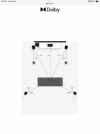
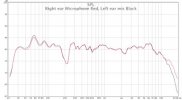
That is the response you get when 2 speakers EQed to fairly flat at the listening position. The Cancellation at 20kHz is proof that the microphones are centrally placed. That response changes to this response that I superimposed over the last graph.
The shape of the blocked ear pinna gain correlate very well to Dr. Toole’s and Sank’s data of pinna gain at 22.5 degrees even though my monitors are at 30 degrees. Even head-on, results are not that different
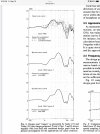
They are not alone:
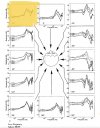
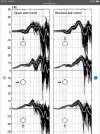
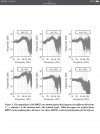
etc..
Then when you add in the head shadow:
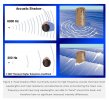
And add a head shadow from the other direction to make a stereo pair:

you take a frequency response that looks like this:
And it becomes this:
Harman’s curve looks to be based on a mono speaker:
But without the air and a lot more low end.
Maybe their missing 6dB, or whatever it was would have been found if they had used a stereo source to begin with?
So why is it that we are so hung up on a graph that more than 2/3 of a lot of people preferred over a different graph if neither graphs are closely related to a stereo triangle? I’m absolutely missing the logic behind it. I made a quick sketch of the regions of the graph to clarify it a little bit, but basically approximately 1,500Hz, we are going to hear both loudspeakers equally. You can tell by my graph that it’s not black and white, but a smooth transition from one condition to the next. Above there, the ipsilateral loudspeaker will be the more dominant sound source. This is a science forum. We should be able to discuss this here with some fluency.
Or this scary one! (Thanks @Robbo99999 )
Neither did I. That was my point: since it’s not and we are science folk, why does it matter? I can EQ my own headphones however I want—IOW, to my exact preference at any point in time and for any recording. Your misunderstanding is the only one present in this conversation.Nobody claims that the Harman curve is neutral. If you assume that to be the claim then everything built on that misunderstanding is what leads you to saying "it's really unclear".
Similar threads
- Replies
- 1K
- Views
- 191K
- Replies
- 1K
- Views
- 280K
- Replies
- 385
- Views
- 72K
- Replies
- 9
- Views
- 919
